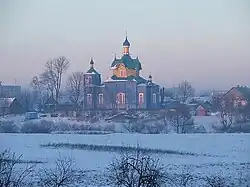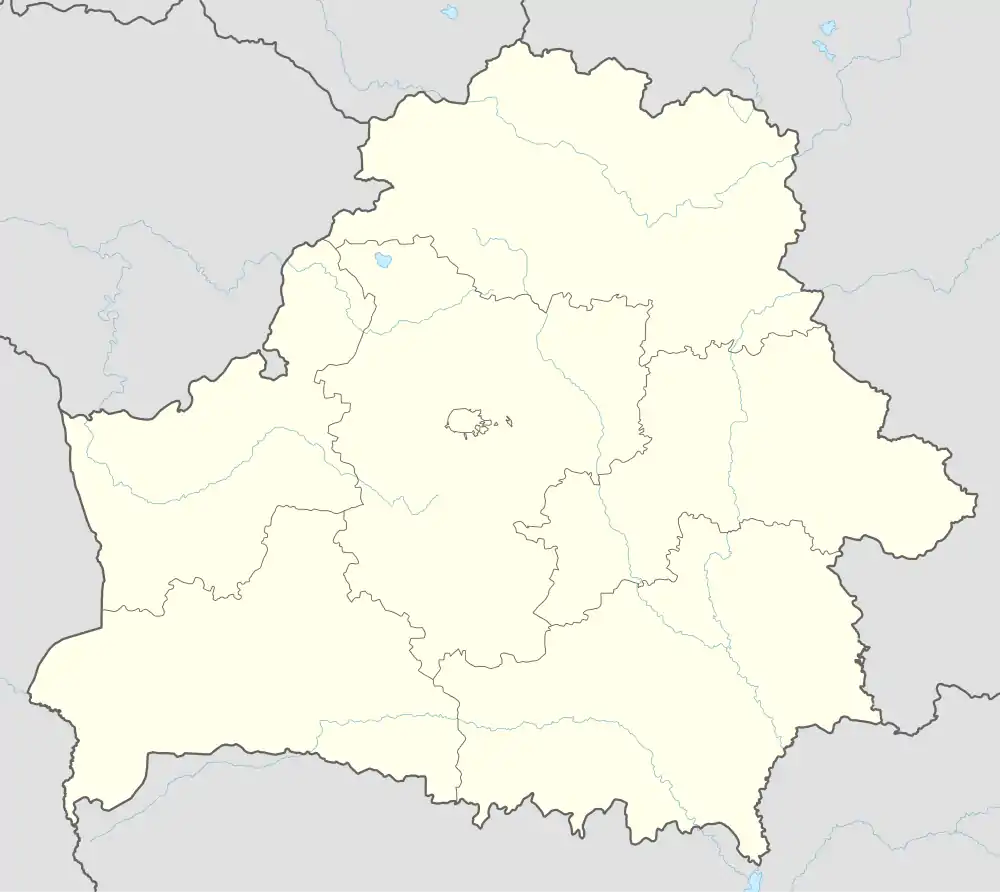Sharkawshchyna
Sharkawshchyna[lower-alpha 1] or Sharkovshchina (Belarusian: Шаркаўшчына, romanized: Šarkaŭščyna;[lower-alpha 2] Russian: Шарковщина; Polish: Szarkowszczyna; Yiddish: שאַרקוישטשינע, romanized: Sharkoyshtchine) is an urban-type settlement in Vitebsk Region, Belarus.[1] It serves as the administrative center of Sharkawshchyna District.[2] Population: 6,107 (2023);[1] 6,330 (2017);[3] 6,900 (2010).[4]
Sharkawshchyna
| |
|---|---|
 Sharkawshchyna Orthodox church, founded in 1639, rebuilt in 1912. | |
 Flag  Coat of arms | |
 Sharkawshchyna Location in Belarus | |
| Coordinates: 55°22′N 27°28′E | |
| Country | Belarus |
| Region | Vitebsk Region |
| District | Sharkawshchyna District |
| First mentioned | 1503 |
| Elevation | 166 m (545 ft) |
| Population (2023)[1] | |
| • Total | 6,107 |
| Time zone | UTC+3 (MSK) |
| Postal code | 211910 |
| Area code | +375 2154 |
| License plate | 2 |
History
Within the Grand Duchy of Lithuania, Sharkawshchyna was part of Vilnius Voivodeship. In 1793, the town was acquired by the Russian Empire as a result of the Second Partition of Poland.
From 1921 until 1939, Sharkawshchyna was part of the Second Polish Republic. In September 1939, Sharkawshchyna was occupied by the Red Army and, on 14 November 1939, incorporated into the Byelorussian SSR.
From 30 June 1941 until 1 July 1944, Sharkawshchyna was occupied by Nazi Germany and administered as a part of the Generalbezirk Weißruthenien of Reichskommissariat Ostland. In October 1941, 1,900 Jews of the town and surroundings were kept imprisoned in a ghetto. Many died of disease and starvation.[5] On July 17, 1942, 1200 Jews were murdered in a mass execution perpetrated by an einsatzgruppen,[6] some managed to escape when the Judenrat instructed them to run through the lines of the police coming at them. Several days later, most of the survivors, even though they knew their ultimate fate, joined the Jews of the nearby ghetto at Glebokie.[7] This was used by several Holocaust researchers from the "Israel school" of holocaust research, as a study case showing the futility of Jewish resistance in those years.[8]
References
- "Численность населения на 1 января 2023 г. и среднегодовая численность населения за 2022 год по Республике Беларусь в разрезе областей, районов, городов, поселков городского типа". belsat.gov.by. Archived from the original on 17 April 2023. Retrieved 5 October 2023.
- Sharkawshchyna Raion on the website of Vitebsk Region Archived 2010-05-09 at the Wayback Machine
- "Main Geographic Characteristics of the Republic of Belarus. Territory and population density of Belarus by region as of January 1, 2017". Land of Ancestors. The Scientific and Production State Republican Unitary Enterprise “National Cadastre Agency” of the State Property Committee of the Republic of Belarus. 2017. Retrieved 1 January 2017.
- Численность населения по Республике Беларусь, областям и г. Минску (тысяч человек) на 1 января 2010 года Archived 2010-09-18 at the Wayback Machine
- "Technical Problem Form".
- "Szarkowszczyzna - Virtual Shtetl". Archived from the original on 2016-05-05. Retrieved 2016-04-20.
- "המכון הבין-לאומי לחקר השואה - יד ושם".
- The Holocaust and its Aftermath Samuel Kassow, page 665, chapter 23 in The Cambridge History of Judaism, volume VIII The Modern World.